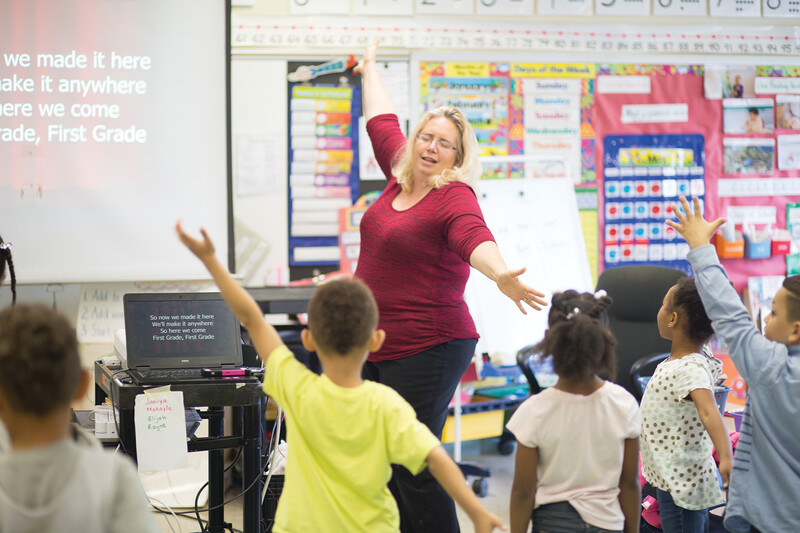After visiting a high school biology class, I asked the teacher why she thought it was worth her effort to set up that day's lab so that students could complete it in several different ways. She looked puzzled at the question, but her answer was direct: "Why do I do this? Because it makes me a better teacher and it makes my students more successful learners."
Knowing this teacher, I'm fairly certain that her concept of making her students "more successful learners" extended beyond covering more content knowledge. The ultimate aim of the work that went into preparing for the lab—her detailed knowledge of her students and her efforts to differentiate instruction to meet their individual needs—was to help her students become focused, motivated, and independent learners. Much more than instruction in biology was going on in that classroom.
Differentiated instruction is student-aware teaching. It is guided by the premise that schools should maximize student potential, not simply bring students to an externally established norm on a test. To grow as much and as rapidly as possible, students must not only learn essential content, but also increasingly take charge of their own lives as learners.
It's Only Logical
There's logic in differentiated instruction when we use it to ensure student mastery of content. Differentiation calls for teachers to have clear learning goals that are rooted in content standards but crafted to ensure student engagement and understanding. If teachers are uncertain about the learning destination, their students are adrift. We want students to go into the world fully possessed of the power of knowledge. Yet what we teach must engage learners, or we've lost them before we've begun.
Thus, differentiation also proposes that teachers must know their students. As one educator noted, it's virtually impossible to make content relevant for learners whom you don't know (Littky, 2004). For many students, lack of connection with the teacher spells academic failure.
Further, differentiation calls on teachers to vigilantly monitor student proximity to content goals throughout a learning cycle. The teacher needs to know what each student knows and can do at a given moment. How else could we plan instruction to increase the likelihood that students stay on course toward the destination?
Differentiation also counsels that—armed with assessment information and other knowledge about a student—the teacher should adapt teaching plans to attend to learner readiness, interest, and preferred modes of learning. Once we understand what a student knows (and doesn't know), what motivates that student to learn, and how the student learns best, differentiation is simply what comes next (Earl, 2003).
So differentiated instruction is a logical way to achieve the goal of content acquisition. But there's a parallel logic in differentiation that functions at a deeper level. Differentiation enables teachers to go beyond the question, How can I make sure a student masters a body of information? asking instead, How can I help create a real learner? As teachers address this question, they need to consider four elements that help students take charge of their own learning and thus take charge of their lives: trust, fit, voice, and awareness.
Building Trust
Trust begins when students believe that the teacher is on their side—when they realize that the teacher views them as persons of worth, believes in their capacity to succeed, and works in their best interest. Trust develops as students become aware that what goes on in the classroom supports their success individually and as a group. This kind of trust creates a partnership of striving for excellence.
In the 2004 summer Olympics, an athlete from an emerging country qualified to compete in swimming because he was the best from his country, a place where training for top-level swimming competition was simply not available. Before he arrived at the Olympic venue, he had never even seen an Olympic-size pool. In his initial heat, he flailed at the water with a stroke so awkward it was painful to watch. As the race progressed, he was clearly out of breath and gasping for air. Spectators feared he would drown. Nonetheless, he swam the entire race. Later in an interview, he confirmed that he, too, was afraid for his safety as he swam. "Why did you continue?" asked the interviewer. "Why didn't you just stop?" Without a pause the young man answered, "Because the people in the stands were clapping so hard for me. I just didn't want to let them down."
That's an apt metaphor for the classroom. When the people around us are pulling for us, when we feel buoyed by their expectations and partnership, we persevere.
Teachers build trust through an accumulation of small, positive exchanges with individual students. They build trust when they take a minute or two each day to share experiences with the class and to build memories, when they listen to student responses with respect, and when they provide ample time for practice and feedback before the judgment of grading. They build trust when they ensure that classroom routines exist to support student success and when they enlist students as partners in implementing those routines. Differentiation provides a structure that supports trust by enabling teachers to actively and optimistically support each student's learning.
Ensuring Fit
A second element that gives students ownership of their learning is making sure that the learning fits the student. Fit suggests that we ask students to do only what they are ready to do. If work is consistently beyond a student's reach, that student becomes more occupied with escaping possible danger or humiliation than with learning. If work is consistently too easy for a student, the student develops strategies for marking time rather than for addressing challenge. In both instances, the student's willingness to persist in the face of difficulty diminishes.
Fit also requires that what we ask students to learn connects with what they care about. When knowledge, understanding, and skill help students make sense of their world, do things they want to do, or develop a sense of personal agency, students will give whatever it takes to succeed.
Further, fit implies that students have the opportunity to learn and to express learning in ways that facilitate their success. Such opportunities make learning efficient rather than cumbersome and enhance the likelihood that students' efforts will lead to success.
Sarah Kajder (2006) found that a large number of students in her high school classroom were discouraged with school and alienated from learning. They didn't read, they told her. They couldn't, and they weren't going to. Meeting them where they were in readiness, interests, and learning modes, she asked the students to find images on the Internet that reflected their feelings about reading. One student brought in a picture of a bulldozer and wrote about how reading tore him apart and destroyed his chances of success. To counteract these feelings, Kajder used graphic novels, digital word walls and flash cards, and online journals to build students' competencies, connect with their worlds, and nurture their expression. Later in the year, one of her students wrote,I don't know what it is about this assignment but I have never taken so much time to read something before. I think maybe it's because I'm taking the time to allow the picture to unfold in my head. (p. 90)
Teachers in differentiated classrooms create fit by using small-group instruction, reading partners, text at varied reading levels, personalized rubrics, miniworkshops, learning contracts, product and task options with common learning goals, independent studies, varied homework assignments, and a host of other strategies—not for the sake of using them, but to make learning work for each student. These teachers are flexible with time, seating arrangements, working conditions, student groupings, and other classroom elements. They assiduously study their students. They use ongoing assessment to understand what a student needs next, and they adjust their teaching in response to what they discover.
When curriculum, instruction, and classroom environment fit a student, the student's sense of possibility increases. The balance of challenge and support, the sense of personal relevance, and the opportunity to learn and express learning in ways that work for the student enhance the student's willingness to risk the hard work of real learning.
Strengthening Voice
Voice, the third element, is an extension and refinement of thought that gives students power over their own destinies as learners. As Parker Palmer (1998) wrote,Learning doesn't happen when students are unable to express their ideas, emotions, confusion, ignorance, and prejudices. In fact, only when people can speak their minds does education have a chance to happen. (p. 74)
Teachers honor student voice by inviting, encouraging, affirming, supporting, mentoring, and responding with honesty.
A pair of high school teachers asked their classes to complete a set of probing questions about the effectiveness of their class so that the teachers could become "their best selves." The teachers shared with their classes the percentage of students who chose each answer as well as some elaborative student responses. The teachers then explained to the students how particular responses would help them adjust instruction. To observers of the class sessions in which student feedback was sought, shared, and acted on, it was clear that students understood the power of their voice (Tomlinson, Brimijoin, & Narvaez, 2008).
Because differentiated instruction enables teachers to individualize so they can better respond to student needs, it provides a nurturing environment for student voice to grow. Teachers cultivate student voice when, among other approaches, they effectively use dialogue journals; make time for student discussions; problem solve with individuals, small groups, and the whole class; ask for student input in developing classroom rules and routines; provide guided choice for tasks and ways of accomplishing them; conduct morning meetings; have students conduct parent conferences; provide opportunities for students to review one another's work using clear criteria; and listen to students' experiences and connect them with content.
Elementary teacher Stephen Levy (1996) explained how he listened to student voices as he crafted curriculum to engage students' minds and spirits:We made all our decisions by consensus. We sat in a circle on the floor, and each person had a chance to state an opinion or pass. After all opinions were heard, students were invited to defend their idea or to explain how their opinion had been modified by what they had heard. Most discussions were very civil, and consensus was clear. (pp. 56–57)
In Levy's class, students owned their learning. Trust and fit, also evident in his classes, are intertwined with voice.
Developing Awareness
Awareness is the final element. Real learners understand how learning works. They know how to make sense of text, how to listen, and how to ask questions. They know how to gauge their work based on criteria for success. They understand how to capitalize on their learning strengths and how to compensate for their weaknesses. They know how to plan, follow through with plans, modify plans when necessary, and evaluate the effectiveness of their planning. Through those avenues, they come to believe that they are captains of their own fate as learners. Teachers who differentiate for student ownership of learning guide each student in developing these abilities.
Monica Harrold, then a 1st grade teacher, frequently led her students to analyze a piece of work they were about to begin with a partner or small group. After she described the task, she'd say, "Now tell me what skills are necessary to do this work really well." Gradually, her young students became proficient at naming the skills the assignment called for. Next, she'd ask them to think about which of the necessary skills they had and which ones they'd need to be sure someone else in the group had. In my observations of Monica's classroom, it was common to hear a student say, "I can draw and I can write, but I'm not very good at finding information so I'll need to work with someone who can do that." At age 6, these students were already becoming metacognitively aware. They were learning to position themselves as successful learners by controlling their working conditions.
Teachers build student awareness as they talk about what they observe in their students, how they plan, why they teach as they do, and how they solve problems in their own work. They use rubrics that are carefully constructed to support student thinking about the quality of their work instead of merely awarding points for completed work. They help students analyze their points of entry in the rubrics and set goals for next steps. They have students keep track of their own skill development, feedback, and grades. They give students opportunities to reflect on their work through exit cards, journals, or plus/ minus/delta charts that aid them in thinking about their strengths, their weaknesses, and the changes they will make as they approach future work.
Academic awareness builds academic success. Success inevitably sends an invitation writ large to pursue further success and to own both its processes and its products.
A Dual Goal
Differentiated instruction is a way of thinking about teaching. Certainly one of its goals is increased student mastery of essential content and skills. But few students will become dedicated learners because their standardized test scores increase. Differentiation, fully understood, is concerned with developing not only content mastery but also student efficacy and ownership of learning.
In a differentiated classroom, even as students grapple with fractions, French verbs, names of explorers, and the periodic table, their teachers strive to build trust, ensure fit, strengthen voice, and develop awareness. These elements help students build a sturdy platform to support the kind of learning that enriches life. Teachers in effectively differentiated classes help students participate in the formation of their own identity as learners. As students come to trust that process, they develop the power and agency they need to become intellectual beings and thus to own the process of learning.







